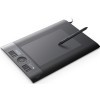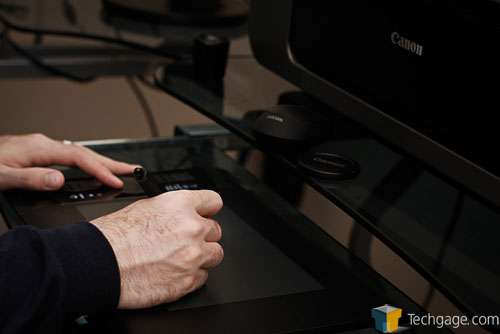- Qualcomm Launches Snapdragon 4 Gen 2 Mobile Platform
- AMD Launches Ryzen PRO 7000 Series Mobile & Desktop Platform
- Intel Launches Sleek Single-Slot Arc Pro A60 Workstation Graphics Card
- NVIDIA Announces Latest Ada Lovelace Additions: GeForce RTX 4060 Ti & RTX 4060
- Maxon Redshift With AMD Radeon GPU Rendering Support Now Available
Wacom’s Intuos4: A Photographer’s Perspective

Wacom’s tablets have long been considered an indispensable tool for novice and professional artists alike, but can they also offer some use to those who couldn’t draw a circle? Our resident photographer, Brett Thomas, takes a look at the Intuos4 “Medium”, to see if it manages to surpass the “perfected” workflow using his desktop mouse.
Page 1 – Introduction
I will start this off with a declaration – an awful lot of my personal photography time is spent in Adobe Photoshop. Over the years, Adobe and I (outside of the pen tool, which I have always hated to bits) have become great friends as I’ve expanded my vision and added atmosphere to what the camera’s lens has captured for me.
It’s not that I suck as a photog (at least, I hope) – my pictures are usually straight, well composed, and not often blurry. But the art of post-processing, even just touch-ups, is almost more exciting than going out and taking the pictures.
Moving from “what the camera saw” to a finished piece for me is often a long and tedious task of dodging, burning, selective blurring and sharpening, tinting, and many other things. In any given “final” piece that I consider print worthy, I probably invest six or more hours in post-process, running through ranges of filters, actions and tweaks – both commercial and personally created.

With that in mind, I was excited when Rob asked me if I’d ever looked at using a Wacom tablet. After all, these things are designed to be a post-process dream come true. I mean, yes, I’m a photographer at heart, but absolutely no image to me is complete straight out of the camera. Every book I’ve ever read on Photoshop screams about the benefits of control that a tablet input device gives you over a mouse.
In fact, it was such a common thought that Rob actually was quite surprised that I hadn’t used one yet, given my dedication to the hobby. However, every real photog that I know who has had one often finds it relegated to the back corners of his or her workspace, stating “It was fun for a while, but frankly I was just faster with a mouse.”
Bound and determined to find out why there is such a discrepancy between the big-time book writers and the in-the-trenches photographers, I decided to see what a Wacom Intuos4 tablet could do for me. This isn’t a typical review of the Intuos4 (you can read that here), or even specific to only the Intuos line – the tablet has been out since 2009 and if you are wanting nitty-gritty specs, there are plenty to be found. Instead, this is a bit more of a narrative and editorial of sorts – an established photographer wondering if and how tablets really do affect workflow, and if they’re worth your consideration.
Sizes, options, and configurations – Oh, my!
The particular Intuos4 model that I have been using for the past couple of months is the “Medium” size, which has an active pad of 5.5 inches x 8.5 inches, and generally retails for around $300. Being a more novice user myself, I can safely guess that most of what I describe in this article will apply to the entirety of the Intuos and also to the lower-priced Wacom Bamboo line, minus one overwhelmingly useful feature – the scroll wheel. This small, seemingly frivolous additional control becomes one of the most touched places on the tablet, and I cannot stress enough that if you are on the fence at all between one model line and the other, the scroll wheel is worth the extra cash to move up to the Intuos line even if you take a slightly smaller pad size (The small Intuos4 retails for just under $200, whereas the biggest Bamboo is $149).
I thought the configuration options would be a little daunting at first, given that all functions are completely programmable – however, installation was a snap and configuration was done before I knew it. The scroll wheel was quickly assigned to the brush size parameter in Photoshop (though I have come to find out that with certain tools, pressure can control not only the opacity of your stroke but also the size) for one mode, and Zoom for another – allowing me a somewhat analog method to control both of these common functions.
The other buttons were indexed to various common tools – selections, the paintbrush, gradient and fill, and particularly a “new layer” and “next layer” keys. This setup seemed (at first) to render my mouse obsolete. A final button was used to change the active display, as I use a separate monitor from my MacBook Pro to do my editing tasks.
Once these things were set, I fired up Adobe Lightroom, and suddenly realized that I’d not assigned anything for that program. Fortunately, the tablet comes with some default controls that I haven’t even needed to tweak yet for LR3, and the pen hovering over the surface of the tablet moves the cursor just like a mouse.

Speaking of, as a side note – the Intuos line comes with a “mouse” to use on the tablet surface so that you don’t have to use your conventional mouse. Don’t bother. Honestly, just save yourself the frustration and find a drawer for all the crap you accumulate as extras attached to the products you actually wanted. You know, all those weird graphics connectors with every card that you never think you’re going to need again, sixteen SATA cables with every motherboard, etc. Find a drawer for all that stuff, and put this mouse in it – never to be seen or heard from again. By the time you A) put down the pen, B) grab the mouse attachment, C) mouse over something that moves SLOWLY by intent because it’s designed for accuracy, and D) pick up the pen again, you’ll realize it was much less work to either grab your normal mouse, or just use the pen.
Support our efforts! With ad revenue at an all-time low for written websites, we're relying more than ever on reader support to help us continue putting so much effort into this type of content. You can support us by becoming a Patron, or by using our Amazon shopping affiliate links listed through our articles. Thanks for your support!





